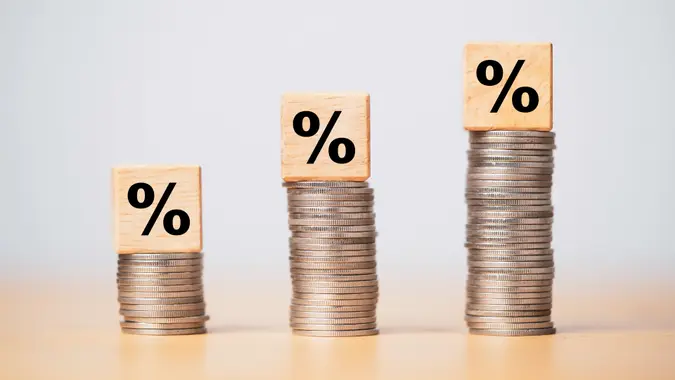How Much Should I Have in My Savings?

Commitment to Our Readers
GOBankingRates' editorial team is committed to bringing you unbiased reviews and information. We use data-driven methodologies to evaluate financial products and services - our reviews and ratings are not influenced by advertisers. You can read more about our editorial guidelines and our products and services review methodology.

20 Years
Helping You Live Richer

Reviewed
by Experts

Trusted by
Millions of Readers
Generally speaking, experts recommend saving 20% of your income. Known as the 50/30/20 rule, this can serve as a guide to help streamline your budget. This works by putting 50% toward necessities (like rent and bills) and the remaining 30% toward discretionary items (like going to the movies).
For example, if you earn $1,000 per month, you would allocate $500 for necessities, $300 for discretionary items and $200 for savings.
The Role of Savings in Financial Health
Having enough money in your savings account is critical for emergencies, big purchases and long-term goals. For example, if you lose your job, you should have enough money saved to cover your basic living expenses while you search for employment.
If you plan to make a big purchase, like a car or a house, then you can create a savings plan to help you reach that financial goal.
Common Savings Goals
The most common savings goals include emergency funds, retirement savings, travel and homeownership.
- Emergency funds: Financial experts stress the importance of an emergency fund to safeguard against unforeseen expenses, advocating for a reserve of three to six months of living costs. This fund, distinct from regular savings and checking accounts, ensures you’re prepared for unpredictable life events.
- Retirement savings: Investment accounts are as unique as your individual finances. The amount you should have depends on the age at which you plan to retire, your savings rate and your desired lifestyle. Saving for retirement typically takes decades. Getting an early start on saving for this big goal in a 401(k) or an individual retirement account can make the process easier.
- Travel: Creating memorable experiences also deserves a spot in your savings strategy. Set aside a dedicated fund for vacations and leisure activities to make sure you can still enjoy well-deserved breaks without impacting your primary financial goals.
- Homeownership: A home purchase is one of the biggest financial commitments people make. Depending on the type of loan, you’ll likely need to save enough money to meet the minimum down payment requirements, as well as closing costs and additional fees. If you plan to buy a home, it’s wise to have a clear savings goal and set up a dedicated fund.
How Much Should You Have in an Emergency Fund?
Most experts recommend having three to six months’ worth of living costs saved.
To calculate your emergency fund target, multiply your monthly expenses by the number of months you aim to cover. For example, if you spend $1,000 per month, then your emergency fund goal might fall between $3,000 and $6,000.
Saving for Retirement
When planning for retirement, a good place to start is saving 15% your income annually beginning at age 25. Here are some guidelines from Fidelity.

Many people set a savings goal of $1 million for retirement. Although that sounds like a lofty goal, investing your retirement savings can help you get there.
Adapting Goals to Your Situation
Keep in mind that these benchmarks are just guidelines. How much you should save depends on your individual circumstances. In reality, you stand to benefit from saving any amount. Setting aside some money, even a tiny amount, is better than not putting anything aside at all. The goal is to save consistently, regardless of the amount, to help build financial security.
Strategies for Building Savings
If your ideal amount doesn’t match the balance currently in your bank account, it’s time to make some changes to your spending habits. Here are a few tips to help boost your savings in no time.
Prioritize and Automate Your Savings
Saying you’re going to put a certain amount of money into your savings account is easy, but actually doing it can be hard. Automate your savings to ensure a portion of every paycheck goes directly into your savings account, bypassing the temptation to spend.
You can even use tools like savings apps or account features to make savings easier. For example, you can set up automatic transfers through your bank or credit union to transfer money from your checking to your savings account. You can also automatically transfer money from your payroll check to different accounts by setting up split direct deposit with your employer. This allows you to set aside a specific amount or portion of your paycheck as soon as you’re paid.
Start Small and Build Consistently
You can always start small with a manageable amount and increase how much you save over time. Having a budget and cutting unnecessary expenses will make it easier to increase the amount you can save.
Take a close look at your spending habits, then make a budget to help reduce expenses. Consider earning extra money to bulk up your savings by picking up another job. This could be anything from serving as a rideshare driver on the weekends to picking up a part-time virtual assistant job. Put your earnings from this gig directly into savings.
Where to Keep Your Savings
Opening dedicated bank accounts for financial goals can streamline your savings efforts, ensuring you’re well-prepared for both the predictable and the unexpected aspects of life. Here’s a closer look at some key savings objectives and strategies for achieving them.
Savings Accounts vs. High-Yield Savings Accounts
Traditional savings accounts and high-yield savings accounts are both good spots to keep your money and earn interest. However, they differ in major ways.
A high-yield savings account (HYSA) pays a higher interest rate than a traditional savings account. According to Fortune, high-yield accounts typically provide rates 10 to 20 times higher than traditional accounts.
An HYSA is a good choice if you want to maximize your savings returns and have short-term savings goals. If you prefer to do your banking in person or plan to make frequent withdrawals, then a regular savings account may be the better option.
Investments for Long-Term Goals
For long-term money goals, you may also want to consider a certificate of deposit (CD). A CD requires you to keep your money in the account for a certain amount of time, typically three to five years. This will help you avoid dipping into your savings.
For financial goals that extend beyond five years, then consider opening a retirement account, such as an individual retirement account (IRA) or 401(k) plan. While the rate of return varies, the average annual return is typically between 5% and 8%. These accounts also come with tax advantages.
Common Mistakes to Avoid
Saving may seem like a straightforward concept, but there are common mistakes that you should avoid.
Over-Saving vs. Under-Saving
It’s possible to over-save by tying up too much cash in low-yield accounts. Keeping too much money in an account that generates little interest means you’re missing out on an opportunity to grow your investment substantially. You are potentially losing earnings on your money because you aren’t taking advantage of high-yield options. On the other hand, under-saving means you aren’t saving enough money to meet your financial goals.
Ignoring Inflation and Investment Growth
Make sure you balance liquid savings with growth-oriented investments. Having cash that’s easily accessible is essential for immediate needs, while investments with higher rates of return allow you to maximize your long-term wealth potential. Balancing these two helps builds a safety net for unexpected expenses while still working toward your bigger financial goals.
Final Take To GO
Most financial experts recommend building up enough savings to cover three to six months’ worth of expenses for emergencies. However, there’s no need to panic if you don’t have anywhere near this amount. Just remember, working to increase your savings account takes time, which you can break down into life stages and specific goals. Instead of feeling discouraged about how long it will take to reach your goal, be proud of yourself for all your hard work and celebrate your increased account balance every time you make a deposit.
Start investing today and make adjustments as your financial situation evolves.
FAQ
Here are the answers to some of the most frequently asked questions regarding how much to have in savings.- Is $20,000 a good amount of savings?
- $20,000 can be a healthy amount of savings, but this largely depends on several factors, including your financial goals, age, income, lifestyle or choice of retirement account.
- What is the ideal amount to have in savings?
- In general, experts agree that you should have between three to six months' worth of expenses saved. For example, if you spend $2,000 per month, then a good amount of emergency savings might range from $6,000 to $12,000. But you might decide to save more or less based on your financial situation.
- Can I have too much money in a savings account?
- Tucking money into a savings account is an important part of building a bright financial future. But in general, it's a good idea to invest some of your funds to build wealth for the future. If you keep too much of your net worth in a savings account, you could miss out on growth opportunities.
- How much should a 30-year-old have in savings?
- Ideally, a 30-year-old should aim to have the equivalent of their annual salary saved. If you're earning $50,000 a year, strive for a savings balance of $50,000.
- How much does an average person have in savings?
- The average savings balance varies widely based on age, income and expenses. According to Northwestern Mutual's 2023 Planning & Progress Study, the average American has $65,100 in savings.
Explore More on Savings Accounts
- What Is a Savings Account? Learn Savings Account Basics
- Types of Savings Accounts: Where Is the Best Place To Put Your Savings?
- How To Open a Savings Account in 4 Steps
- Checking vs. Savings Accounts: What’s the Difference?
- 7 Strategies To Grow Your Savings Account to $1 Million
- Best Savings Accounts
Our in-house research team and on-site financial experts work together to create content that’s accurate, impartial, and up to date. We fact-check every single statistic, quote and fact using trusted primary resources to make sure the information we provide is correct. You can learn more about GOBankingRates’ processes and standards in our editorial policy.
- TIAA. "How much should I save each month?"
- Fortune. "You can get up to 5.00% APY on the best high-yield savings account today, February 19, 2025"
- Consumer Financial Protection Bureau "An essential guide to building an emergency fund"
 Written by
Written by  Edited by
Edited by 
























